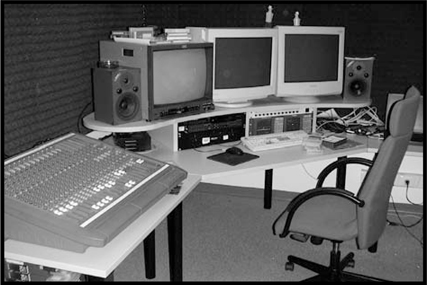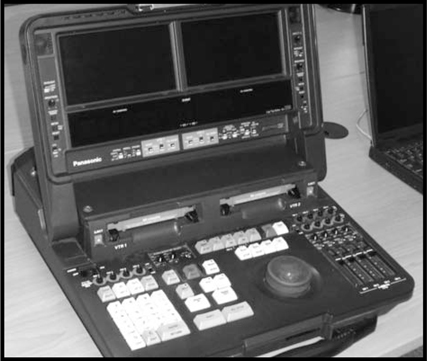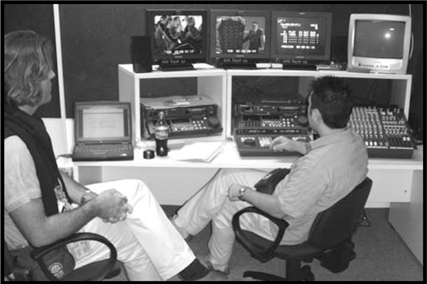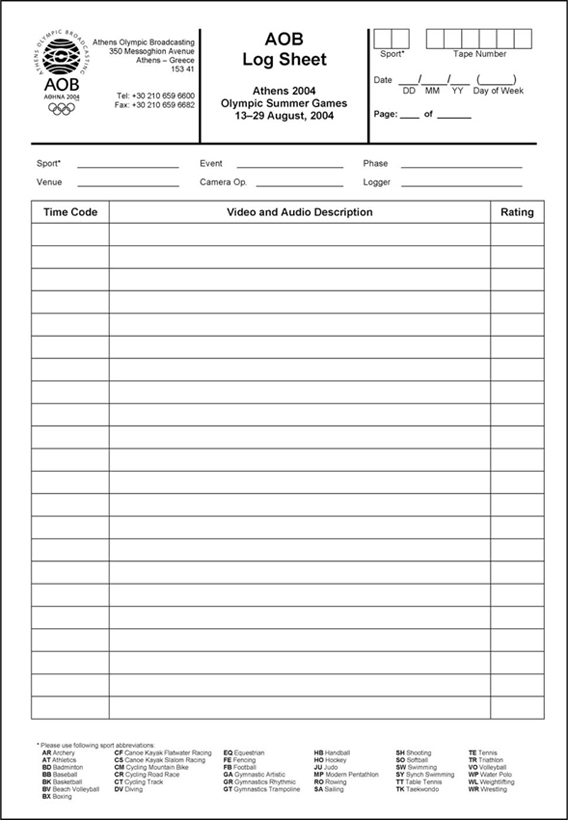CHAPTER 9
Post-production
Post-production gives a producer an opportunity to improve and enhance the original production or correct a mistake. Often it is said, “Don’t worry, we’ll fix it in post.”
Gary Milkis, Director Eight Olympics
At its most basic level, post-production is the process of combining individual shots in a desired order. It can have several purposes:
• To assemble material in a sequential fashion. The competition may have been shot over a number of days and then assembled into one program.
• To correct mistakes by cutting them out or by covering them with other material. The on-camera talent may have made a mistake, but an editor can remove those few seconds or cover them with another shot so that the performance appears to flow flawlessly.
• To create (often re-create), enhance, embellish, and bring to life images and events that were once captured live. Tools such as visual effects, sound effects, and music can give the story more drama, thus more impact on the audience. Slower portions of the competition are often edited out, allowing the production’s pacing to move along. Features are added to give the viewer a more in-depth knowledge of a participant or part of the event. The various segments of the event are then assembled into a cohesive production.
The producer supervises the entire editing process with primary concern for keeping the program within the network or station’s production guidelines or look. The producer also needs to keep the project on time and on budget. The editor is responsible for operating the editing equipment and combining the various shots in the desired order based on information from the producer. The production assistant (PA) assists the editor by logging footage, keeping track of administrative details, and organizing footage for the edit session. The PA may also be responsible for overseeing the creation of the graphics. The sound editor operates the sound editing equipment, provides edited dialogue, voiceovers, sound effects, and music tracks for the final edit.
It is imperative to maintain post-production continuity. Continuity means that when the production is edited, the viewer should perceive it as a continuous flow and should not be aware that it was assembled from a series of segments that were shot out of order. For example, the opening and some of the features may have been shot the day before the event.
Live productions require very little post-production work other than elements such as opening animations, sound bites or personality features that need to be produced prior to the broadcast. When the production is shot there may be some production reports to complete and, possibly, a post-production meeting to discuss the various aspects of the production with those involved. The post-production meeting gives the producer an opportunity to evaluate the production by listening to crew feedback. They can use the information learned in this meeting to improve future productions.
Figure 9.1: Non-linear editors digitize the footage for manipulation by a computer.

Figure 9.2: Digital linear editing laptops are popular for sports news.

Figure 9.3: Linear editors are slowly being phased out of the production process.

Live-to-tape productions require extensive post-production work. After the event, the director or producer may want to shoot interviews with some of the outstanding athletes in the event. These will usually be shot with an ENG camera. The tapes are then taken to a post-production facility for editing.
Before the editing can begin, the program footage needs to be logged. This requires someone, often a production assistant, to review all the footage and write down the tape identification number, a description of the footage, any appropriate notes (great shot, bad audio), and the location, generally in time code, where the footage can be found on the tape. It is important to effectively and concisely translate the visuals into descriptive words. Most editors require the in point or beginning point of each new shot and the out point or ending point of the shot. A log can be as simple as a list on a plain piece of paper, a printed log sheet, or the log could be generated using computer software. Logging saves time in the edit suite if the appropriate shots have been selected and the time code location noted. See figure 9.4 for an example of a logging sheet used to document the contents of a videotape.
Figure 9.4: Logging sheet used to document the contents of a videotape.

After shooting the 2000 Women’s Series NorAm Cup to tape, NBC Sports spent approximately three and a half days in post-production which included:
Day 1: Digitize program into non-linear editor (midafternoon, day of shoot)
The digitization process is when the program content, generally recorded onto tape during the live event, is played (digitized) into the computer of a non-linear editor. This process is time-consuming, done in real time. However, once the program is in the computer, the content can be easily edited and manipulated.
Day 2: Edit tease, features, ski segments, and bumpers.
The tease is a short package used to promote the upcoming broadcast event. It is usually edited in a dramatic way to grab attention and convince the viewer to tune in.
Features are video packages that highlight someone or something that is related to the sports event. A feature may be an up close and personal view of an athlete or a behind the scenes look at some part of the event. Features are generally short packages that are edited into the final production in order to hold the audience’s attention.
Ski segments refer to the ski portions of the competition being broadcast.
Bumpers are generally dramatic shots, often high angle, low angle or spectacular scenery shots, used as transitions between the show segments and commercials.
Day 3. Composite show and create graphics. Compositing is the editing of the video when visual and sound effects are overlaid and graphics added.
Graphics may be created from scratch or may be typed into a pre-produced template or graphic shell.
Day 4. Record talent voice-overs, mix audio, and complete show.
Since the live-to-tape production is generally shortened, keeping primarily the highlights in the program, the original talent’s commentary may not be used. This means that a voice-over will need to take place in a recording studio. The talent must attempt to match the voice energy to the type of energy they would have if they were at the event so that the voiceover sounds like the real thing.
The audio is then mixed, adding the new voiceover track with real venue sound sweetened with sound effects to add realism.
The audio and video components are then edited together to create the final program.
If the show was entirely shot by multiple ENG cameras, the very time-consuming process of cutting an entire show from separate cameras will take place during post-production. Live-totape productions also require production reports and possibly post-production meetings.
Editing Guidelines
Post-production is like falling into a mud puddle and coming up with a fish in your pocket. It is the process of forging a glorious result from a seemingly untameable beast.
—Stephen Fleming, Coordinating Producer, Athens Olympic Broadcasting
• A change of time, slow motion shot or reverse angle shot is indicated by a dissolve, wipe or digital video effect (DVE).
• A change of geographical location is often indicated by a dissolve, wipe or DVE, and a new establishing shot.
• A program intended to be sequential avoids jump cuts, meaning cutting between two shots that are so similar that the subject appears to jump on screen. The use of a cutaway in between the two shots helps to avoid the jump.
• In general, programs avoid cutting from a camera shot that is in motion—that is, in the middle of a pan, tilt or zoom—to a still camera shot since this is jarring to the viewer. It is better to move from a shot in motion to another shot in motion, and to move from one still shot to another. If you need to get from a shot that is in motion to one that is still, ideally you wait until the moving shot has completed its move. In other words, wait until it is a still shot and then cut to the still shot.
• Cuts should occur during subject movement rather than before or after it. For instance, if a person is about to stand up from the bench, the best place to cut from the medium shot of the person on the bench to the long shot is when the person is in the middle of standing up.
• Cuts should not occur without motivation. The viewer shouldn’t notice the edit and wonder why it occurred. In general, it is time to make an edit when:
(a) The current shot has been on screen long enough for the audience to take in all the pertinent information. This could be as short as one second for a very simple shot or much longer for a shot in motion. The issue of pacing is more an art form than a science.
(b) Another shot would help to develop the story, advancing the plot and maintaining good pacing. If an athlete scores, it would make sense to cut quickly to the reaction of teammates or the crowd. This will help move the story forward.
(Kathy Bruner contributed to this chapter.)
